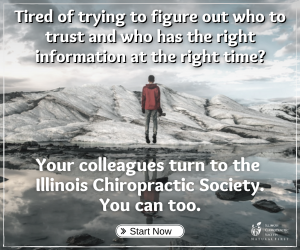
Opioid or Natural First?

Opioid overuse and abuse is a significant problem in the United States today, and this epidemic continues to capture the attention of the government and major health care provider groups. In fact, the number of articles and peer-reviewed studies that have been published in just the last year are daunting; Spine Journal, JAAOS, JAMA, CDC publications and others have all addressed our nation’s continuing opioid problem. As abuse continues to increase, legislative bodies in various states (see the article by Rob French on page XX concerning Illinois) and the federal government continue to legislate in an attempt to address the overall problem: deaths from opioid overdose now exceeds one-third of all overdose deaths combined.[1]
The problem has reached such a significant level that the Centers for Disease Control and Prevention (CDC) allocates a large portion of its website and publications to prescription drug abuse. The CDC introduction clearly states the importance of the need to address the issue: “Since 1999, the amount of prescription painkillers prescribed and sold in the U.S. has nearly quadrupled, yet there has not been an overall change in the amount of pain that Americans report. Overprescribing leads to more abuse and more overdose deaths.” Although studies indicate the opioid abuse has leveled off over the last few years, overall acceptance of opioid prescriptions for chronic back pain continues to increase.[2]
By the numbers:
- 44 – Number of people that die every day from prescription drug overdose.[3]
- 80 – Percentage of the world’s opioids that are consumed in the US.[4]
- 12 Million – Number of Americans that reported using prescription painkillers for nonmedical purposes.[5]
- 1.1 Billion – Amount Medicare spends on Oxycodone Hcl a year[6] – well over twice the amount spent on all chiropractic services.[7]
- 100 – The number of opioid prescriptions written for every 100 American adults.[8]
- 68 – The number of opioid prescriptions written in Illinois for every 100 people in 2012 (Alabama was 143 for every 100).vi
- 1 – The number of chiropractic physicians that it takes to help a patient experience prescription drug-free pain relief.
Although the scope of practice for chiropractic physicians specifically excludes prescription drugs, the nature of the conditions you treat (including chronic pain) makes it likely that you frequently see patients, who are experiencing a prescription drug abuse problem. Additionally, intake forms and electronic health record’s drug reconciliation provide for the accounting of prescription medications in a chiropractic physician’s office. Now that our doctors have access to this patient information, we have a responsibility to address the issue without breaking chiropractic scope by giving advice and recommendations regarding prescription drugs.
Walking this legal tightrope can be a challenge. However, there are some steps that you are able to take:
- Familiarize yourself with the overall issues and problem;
- Obtain education that will assist you in recognizing when a patient presents in your office with an abuse problem;
- Refer a patient presenting signs of prescription drug abuse to an Addiction Specialist, an Addiction Treatment Provider, or to the patient’s medical doctor for specific prescription drug counseling.
In order to assist our members with these steps, the ICS has put together a resource page (www.ilchiro.org//opioids) for our doctors that includes:
- Addiction Treatment Provider Locator;
- Resources on how to recognize opioid addiction and abuse;
- CDC’s section on prescription drug overdose’
- Information on Illinois’ legislative response in 2015; and
- Information about upcoming seminars on prescription drug abuse through the Illinois Alcohol and Drug Dependency Association (IADDA).
While major health care players continue to discuss the opioid abuse crisis in the United States, chiropractic physicians continue to be a viable “natural first” resource to help curb the problem in our affected patients.
References:
- “Prescription Drug Overdose Data.” Centers for Disease Control and Prevention. Centers for Disease Control and Prevention, 16 Oct. 2015. Web. 20 Oct. 2015.
- Injury Prevention & Control: Prescription Drug Overdose. Centers for Disease Control and Prevention, 16 Sept. 2015. Web. 21 Oct. 2015.
- “Understanding the Epidemic.” Centers for Disease Control and Prevention. Centers for Disease Control and Prevention, 17 Aug. 2015. Web. 21 Oct. 2015.
- J. Morris, H.R. Mir. The Opioid Epidemic: Impact on Orthopaedic Surgery. Journal of the American Academy of Orthopaedic Surgeons, 2015; 23 (5): 267 DOI: 10.5435/JAAOS-D-14-00163
- “Prescription Painkiller Overdoses in the US.” Centers for Disease Control and Prevention. Centers for Disease Control and Prevention, 01 Nov. 2011. Web. 21 Oct. 2015.
- “CMS Spent $103 Billion on Medicare Part D in 2013, $2.5 Billion on Nexium.” Healthcare Finance News. N.p., n.d. Web. 21 Oct. 2015.
- United States of America. Department of Health and Human Services. Office of Inspector General. CMS Should Use Targeted Tactics To Curb Questionable And Inappropriate Payments For Chiropractic Services. N.p.: n.p., n.d. Print. September 2015 OEI-01-14-00200
- “Opioid Painkiller Prescribing.” Centers for Disease Control and Prevention. Centers for Disease Control and Prevention, 01 July 2014. Web. 21 Oct. 2015.


















